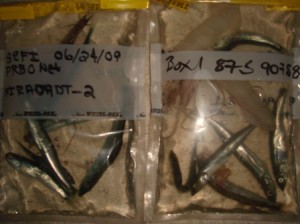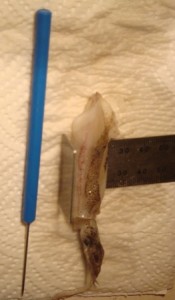So, as you might have guessed by the title of this entry, I just had a twenty-hour workday. More about that in a moment. The last two days have been foggy and a little cold. Things were damp and overcast, and in the mornings it was hard to get out of bed. Today, however, was a different story. After a foggy early morning, the sun broke through, and the entire sky cleared to an incredible blue. The color of the ocean was absolutely brilliant, the breeze was just right, and everything looked amazing. Today was the kind of day that, if everyone could experience, would make everyone want to move to the Farallones (thank goodness they don’t). This island really is beautiful, and every day is different!
So, back to the twenty-hour day. We are reaching pretty much the peak of the seabird season right now. Cassin’s Auklets are starting to fledge, but we still check their boxes every day. Murre chicks are growing slowly, though Murres are having a tough year in general, and we perform attendance on them every day (a procedure that, for my plot, called Upper Upper, takes at least 3 hours a day). Common Murre diet watches are still happening every day for two hours, and two days ago was our second all-day diet watch, so I spent four hours in the blind. Pigeon Guillemot chicks are hatching in large numbers, and so we have begun Pigeon Guillemot diet watches, a four-hour process every three days. These diet watches began yesterday, and the first shift was from 7 to 9am.
Yesterday, we were all up around 6:30am so that we could get down to the diet watch site by 7 am. I spent from 7am to 9am gazing through the fog trying to identify the tiny fish brought in by the tiny Pigeon Guillemots as they zoomed into their crevices. Then from 9 to 12:30, I did Murre attendance. After a quick lunch, I did my daily Cassin’s Auklet Chick Checks, and then had a short break. After dinner, we started another project, mist netting Rhinocerous Auklets. This mist-netting project is another way of monitoring diet, this time for a large tubenose called a Rhinocerous Auklet (I will try to have pictures of them tomorrow).
For Rhinos, we will mistnet four nights in a row, opening the net around 9:30 each night. In this picture, you can see the mistnet strung up, but it hasn’t been opened (if it had been opened, you wouldn’t be able to see it!). We mistnet rhinos until we have caught five Cassin’s Auklets, which we are trying NOT to catch (the cap of five cassin’s is for us to try to minimize disturbance).
When the rhinos are caught, one person leaps up to get them out of the net, and the other person searches the ground nearby to collect any fish the rhino might have been carrying, which can fly great distances when the bird collides with the net.
The bird and the fish are processed together (meaning we take information on them both at the same time before letting the bird go), and ultimately, all of the fish are identified down to the species level.
There’s a lot of variety in the Rhinocerous Auklet diet, and it took a little while to ID all of the fish.
We did catch some pretty cool stuff though!
Here you can see a squid (the bird that brought this in actually had two squid) being measured.
We take several measurements on each fish before we freeze it, immersed in water, in a bag.
The coolest fish we caught was definitely this juvenile Myctophid, a deep-sea species of fish. In this picture, you can see its large, blue, lantern-like eyes; however, you can also see the rows of photophores along its belly. The photophores, the little gold spots all along the underside of the fish, are light-producing cells, useful in a dark environment like the one where this fish lives.
We finished rhino netting fairly quickly last night, by around 10:00, and, because conditions were right, we decided to go and mistnet for Ashy Storm Petrels as well. Conditions were great when we started, dark and calm, but after about an hour of sitting there, the wind picked up and a very dense bank of fog rolled in. Everything got really wet–the net was dripping, the birds were dripping, and all of the people were dripping. The ground was even slippery. But, having started the netting process, we decided to just push through and finish it, wrapping up the net around 2:00am.
Thus concluded the twenty-hour work day, and the next day (today!) began a little later than usual, around 8:45 am. I got up then to help Russ and Caitie do a boat landing, because we have three guests tonight! One of them, Matt, is from the California Academy of the Sciences, and is here to work on our internet connection as well as the web-cam up at the lighthouse. The other two, Cathy and Kevin, are from the Fish and Wildlife Service. The study they are performing is a follow-up to a study that was performed recently, which analyzed soil samples from around the island for contaminants. The results of the soil study are shocking–there are places on the island where lead is found in concentrations as high as 11,000 parts per million (according to the study, healthy rates are less than 100 parts per million). As follow up, Cathy and Kevin are collecting dead (unhatched) eggs, as well as feather samples from chicks, from around the island, and testing them for contaminants.
The visitors were nice enough to bring out some frozen pizzas and fresh produce for a salad, so they’re cooking dinner for us tonight, a treat! It is also my shower day, so I’m pretty excited for that. Tonight, we will go out mistnetting again, at a different location, but it will probably be done (for real this time) by 11:00.
Tomorrow we have another boat landing, this time another film crew, who will only be here for a day.
Busy stuff, and it never stops!!
Best,
Eleanor




